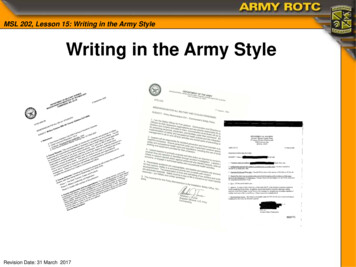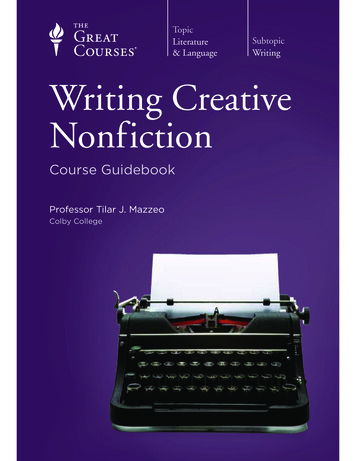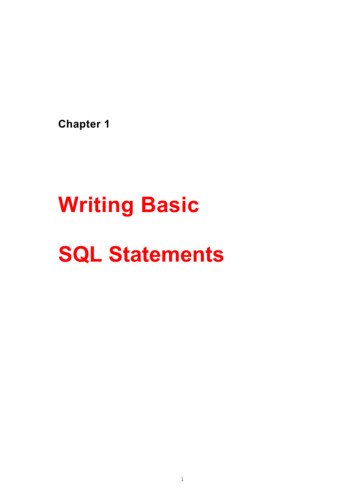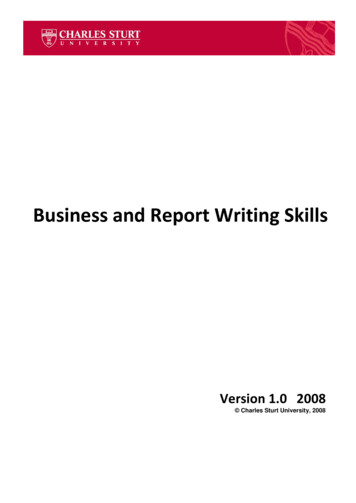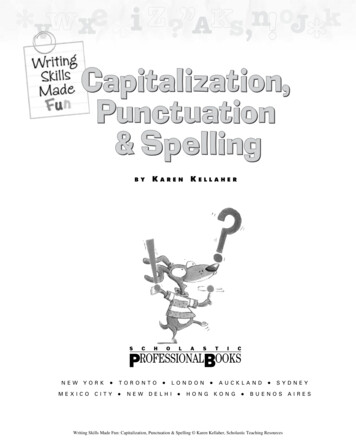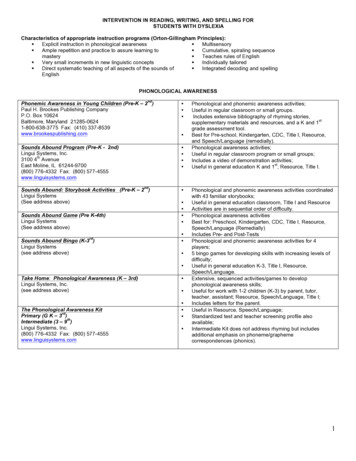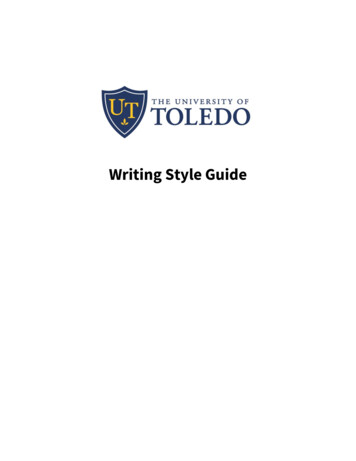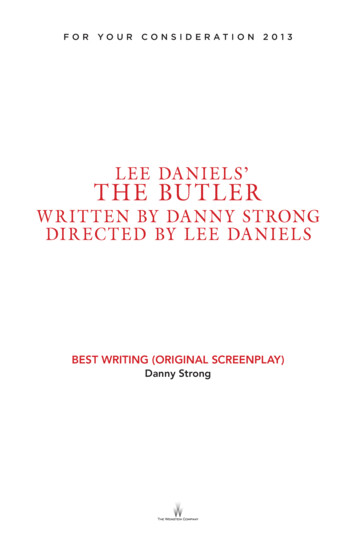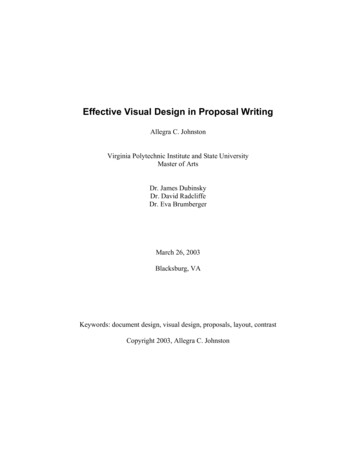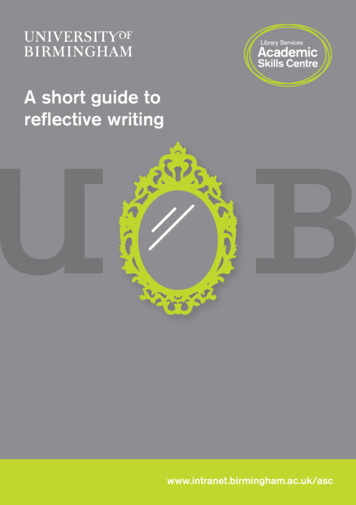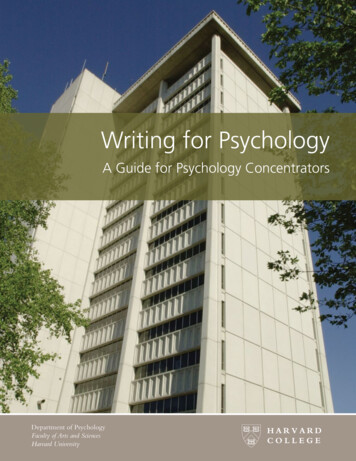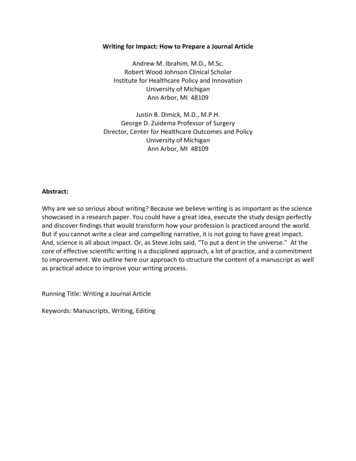
Transcription
Writing for Impact: How to Prepare a Journal ArticleAndrew M. Ibrahim, M.D., M.Sc.Robert Wood Johnson Clinical ScholarInstitute for Healthcare Policy and InnovationUniversity of MichiganAnn Arbor, MI 48109Justin B. Dimick, M.D., M.P.H.George D. Zuidema Professor of SurgeryDirector, Center for Healthcare Outcomes and PolicyUniversity of MichiganAnn Arbor, MI 48109Abstract:Why are we so serious about writing? Because we believe writing is as important as the scienceshowcased in a research paper. You could have a great idea, execute the study design perfectlyand discover findings that would transform how your profession is practiced around the world.But if you cannot write a clear and compelling narrative, it is not going to have great impact.And, science is all about impact. Or, as Steve Jobs said, “To put a dent in the universe.” At thecore of effective scientific writing is a disciplined approach, a lot of practice, and a commitmentto improvement. We outline here our approach to structure the content of a manuscript as wellas practical advice to improve your writing process.Running Title: Writing a Journal ArticleKeywords: Manuscripts, Writing, Editing
“I would not give a fig for the simplicity this side of complexity, but I would give my life for thesimplicity on the other side of complexity.”- Oliver Wendell Holmes, Jr., United State Supreme Court Justice, 1902-1932WHY YOU SHOULD GET SERIOUS ABOUT YOUR WRITINGConsider a few of our highest impact scientific journals, such as New England Journal ofMedicine (NEJM) and the Journal of the American Medical Association (JAMA). Publishing inthese journals, or other high impact factor journals, can lead to significant changes in clinicalpractice and policy. What do these high impact publications have in common? Besides having agreat idea and a well-executed study, they also have a clear and compelling narrative thatmakes the research accessible to their audience. There are a countless number of importantscientific discoveries that never realize their potential impact because they are buried withinpoorly written manuscripts.“The impact ofyour research islimited by yourability toeffectivelycommunicatethe findings andimplications ofthe work.”The importance of writing a clear and compelling manuscript appliesbeyond the top tier publications. Even if you are a seasoned writer andresearcher, most of your work will not be in these journals. But youshould still write with the same clarity and focus as this will increase theimpact of your work no matter where it is published. The impact of yourresearch is limited by your ability to effectively communicate the findingsand implications of the work.Perhaps the most valuable reason to get serious about writing goesbeyond manuscripts. Becoming a more effective writer will teach youhow to communicate complex ideas into a logical and clear narrative.Such a skill is necessary to other responsibilities often encounter by academic researchers:public speaking, grant writing, or institutional leadership positions. We point out thetransferable nature of writing skills to overall professional development to help you justifyputting in the time necessary to become an effective communicator.The remainder of this chapter is organized into two sections. First, we outline how to structurethe key content that should be included in a scientific manuscript. It draws on seminal workfrom Gil Welch –“Preparing Manuscripts for Submission to Medical Journals: The PaperTrail”1—that we have adopted and tailored on over time. Second, we offer some practicaladvice on how to improve your writing process. These lessons come directly from our ownlearning curve as authors, our observations as peer-reviewers, and experience working withmentees.
THE CONTENT OF A SCIENTIFIC MANUSCRIPTScientific manuscripts submitted to academic journals are generally organized in the following order: AbstractIntroductionMethodsResultsDiscussionTables and FiguresThere is some variation from journal to journal on the details that should be included withineach section. On the website of each journal you will find “Instructions for the Authors” thatwill detail any deviation from this format.We discuss below each section separately.AbstractWhat is in an Abstract?The abstract section of a manuscript is a summary (often 300 words or less) of the researcharticle. It typically follows the same format as the article (i.e. introduction, methods, results,conclusion) but in an abbreviated form.Although your main manuscript may include multiple findings, the abstract only has space tofocus on one or two key findings. As such, you should spend time thinking about which is themost important. Take time to ensure your introduction, methods, results and conclusion areconsistent within your abstract. For example, your paper may examine multiple outcomes (e.g.complications, mortality, costs) but you only plan to focus on mortality and costs in theabstract. Your introduction, methods, results and conclusion should all be tailored to those twooutcomes. Readers will be very confused if state in your abstract that studied three outcomes,but then only report on two in the results of the abstract.The Three Roles of an Abstract Across the Manuscript TimelineAn abstract takes on three different roles from the time you start writing, once it’s submittedand after it is published (Figure 1).
1. When Writing: Improve Your Research Question.We recommend that you write the abstract first because it helps you refine the narrative of theproject. We even encourage doing so before you even have data with placeholder results (e.g.“XX%”, “YY%”) assuming a number of possibilities. This exercise will help you focus the researchquestion, clarify which outcomes you want to evaluate and assess if your study design and dataare appropriate. If you cannot trouble shoot these issues and write a compelling abstract withplaceholder results, you should stop. This is a sign you need to refine or change your researchquestion before wasting time executing the work plan.2. Once Submitted: Convince Editors It’s Worth of Peer-Reviewed.The abstract is where journal editors will look first to decide if the manuscript should be sentout for peer review. At high-impact journals, more than half of the submissions will be rejectedbased primarily on the abstract. A common mistake here is to overstate the importance of yourfindings with a “conclusion” that is not supported by the results. Editors have a sharp radar forthis type of “overreach” and it gives them an easy reason to quickly reject your work.Remember, this last section of the abstract is labeled “conclusions” not “editorialoverreaching”.3. After Publication: Getting the Rest of the Article Read.The abstract is the first section that readers encounter to decide whether or not they want toread the entire article. Many readers may never read past the abstract, so it is important tomake sure you’ve communicated your key message. A poorly written abstract will not enticereaders to spend time on more poorly written prose.IntroductionThe purpose of the introduction is to give context to the question, create a knowledge gap andpreview your study plan. We feel this is done more effectively with three distinct paragraphs(Figure 2).Paragraph 1: Give Context to the ProblemThe first paragraph of the introduction should get the reader to care about the topic. It needsto bring the reader up to speed on the why the topic is important. For example, if your paper isevaluating a federal payment policy, you’ll need to help the reader quickly understand why thepolicy was created and what is important about it now.Common mistakes here are to give context that is too broad or too narrow for your audience.Most people start too broad and tell their audience things they already know. For example, let’sconsider a manuscript about colorectal cancer. Starting off with, “Colorectal cancer is thebiggest killer in America” is not good. Almost all papers start that way, but you lose a hugeopportunity because you are telling people things they already know. The only time it is okay to
start a manuscript with a sentence like, “Every year in the United States there are 100,000cases of XXX” is when you are writing about epidemiology and you are going to say that numberis wrong – it is actually 200,000.You have to establish the right entry point for your topic. If you start too broad you (A) puteveryone to sleep and (B) are will take up too much writing space getting people all the way upto your knowledge gaps.Paragraph 2: Create a Knowledge GapThe second paragraph needs to get the reader curious by creating a knowledge gap betweenwhat is known and unknown. You should not summarize all the literature on the topic here, buthighlight the areas that have tension or uncertainty related to your study question. Theknowledge gaps you introduce in this paragraph should directly correlate with the outcomesthat your study will address.This is the hardest paragraph of the introduction to write for a fewreasons. First, you actually have to know exactly what is known andunknown. Second, that knowledge gap needs to be exactly what yourstudy is designed to do. Third, you need to put those both together in acompelling narrative that convinces the reader it is an important gap inthe literature that needs to be addressed. For example, if your paper isabout the long-term outcomes of colorectal cancer patients aftersurgery, you need to set up related knowledge gaps. Did previous studiesnot follow patients long enough? Are most of the studies focused onnarrow subpopulations? Whatever gaps you choose to highlight hereshould play right into the strengths of your study (e.g. longer follow-up,more representative study participants, etc). Ideally, by the end of this paragraph, the readershould be thinking, “If only there was a study with longer follow up and a more representativesample, we would understand this topic so much better.” Bingo – then you tell them (Paragraph3) that’s exactly what your study will do!“The knowledgegaps youintroduce in thisparagraphshould directlycorrelate withthe outcomesthat your studywill address.”Paragraph 3: Preview Your Work PlanThe third paragraph of the introduction should preview your work plan, i.e., briefly explain howyou will close the knowledge gap discussed in the prior paragraph. Save the details for themethods section, but simply state the database and the outcomes you’re going to use. Again,the outcomes should directly line up with the knowledge gaps you just created. If you wrote thefirst two paragraphs correctly – motivated why the topic is important, highlighted areas wherethere are knowledge gaps – then this should be an easy paragraph to write.If you’re having trouble with paragraph 3, go back and look at paragraph 2 again. A commonmistake is to highlight too many knowledge gaps. You get the reader curious about so many
controversial areas in the topic, then provide a huge let down in paragraph 3 when they realizeyour study is only going to fill one of them.MethodsThe methods sections should explain how the study was conducted. There are differentconventions on what needs to be reported here for different study designs (e.g. randomizedcontrol trials, survey data, qualitative interviews, etc). We recommend looking at previousarticles from the journal your targeting and/or your mentor to see how this section wasorganized.For many papers, the methods sections will include these sub-sections: Data Source – what data did you use? (e.g. Medicare Claims)Patient Population – who did you study? (e.g. all patients undergoing surgery forcolorectal cancer)Outcomes – what did you measure? (e.g. 30-day complications, readmissions)Statistical Analysis – What methods did you use? (e.g. multivariable logistic regression)“A detailed readingof your mentor’sprior work willlikely yield most ofthe methods thatyou willneed Rewritethem in your ownvoice, with an eyetowards creating aclear linearnarrative.”Each of those headings, on average, will be two paragraphs. Again, werecommend following precedent from previous papers with similarmethodological approach to guide you here. Chances are your mentorwould have used most of these same methods before. A detailedreading of your mentor’s prior work will likely yield most of themethods that you will need. However, you do not want to simplyplagiarize prior work. Rewrite them in your own voice, with an eyetowards creating a clear linear narrative, emphasizing those methodsmost relevant to your current study. There may be a few areas that areentirely new, and those are the ones you should spend the most timecrafting with your mentor.ResultsThe results section details the findings from the analysis. This should be reported in multipleparagraphs starting with one that describes the patient characteristics. If applicable, the nextparagraph should describe the hospital characteristics of the groups being compared.The next 2-3 paragraphs should describe the outcomes of the study. These should be statedobjectively. Avoid phrases like, “Surprisingly, we found ” or “Contrary to what we expected ”This section should simply present the information without any editorializing or interpretation.
You should present the outcomes in the same order that you introduced them in the methods.Start with your primary outcome, then your secondary outcomes as appropriate.Each of the tables and references in the article should be references in the results section. Infact, this is a good strategy to avoid repeating lines and lines of results that are already clearlypresented in the tables and figures.DiscussionThe discussion section is your opportunity to connect the previous three sections—introductions, methods, results—together and put them into the broader context of the topic.We typically use a 5 paragraph approach for this section that includes four components (Figure3).Paragraph 1: Summarize the FindingsThe first paragraph of the discussion should be used to summarize the 1 or 2 key findings fromthe study. You’ve taken the reader on a long journey so far, so this is a good time to “refresh” inplain language what this study was about and what the key findings were.Paragraphs 2-3: Put Your Findings Into ContextThe next two paragraphs are used to place your main findings into context. You may havereferenced some of this information in the introduction, but this is your chance to take adeeper dive. In addition to summarizing previous similar studies, end each paragraph with anadditional sentence about how your research builds or adds to this prior work. It may challengeprevious findings, or extended a deeper understanding of them. If you can't write that sentencebecause your research demonstrates the exact same findings as eight prior studies on thistopic, don't write the paper.An important style point here: authors who have written on the same topic will likely be areviewer of your paper. So make sure you reference them appropriately and describe theirstudy accurately.Paragraph 4: Recognize LimitationsNo study is perfect, including yours. The easiest way to annoy an editor or a reviewer is toignore the limitations of your study.Limitations are design features of your study that threaten the validity of the findings. You wantto discuss three to five main limitations, which fall into the three main categories of threats tovalidity: Chance, bias, and confounding.
Chance is random error. Addressing random error means making sure the statisticalcomparisons are adequately powered and analyzed with appropriate tests.Bias is systematic error. Addressing systematic error means discussing which strategiesyou used to ensure that these biases did not make your study results invalid, e.g.,making sure you have a strategy for addressing selection bias.Confounding is when there are variables that are associated with the exposure andoutcome that are actually driving your results, rather than a true relationship betweenexposure and outcome. Addressing confounding includes a thorough discussion of howyou were able to address confounding with study design and/or methodologically.To really take advantage of this section, you will want to provide a counter point about how youtried to mitigate that limitation or why it may not threaten your entire study. You can think of itas prophylactically addressing concerns you think will come up from reviewers. It willdemonstrate you were thoughtful about the study design, and are not overreaching yourconclusion.Paragraphs 5: Implications Moving ForwardThe last paragraph of the manuscript should discuss the implications of your findings. Anextremely common mistake here is to simply conclude “more research is needed.” Do not dothat. It makes everyone mad and cheapens your value as an author. Take a more sophisticatedand detailed perspective with your recommendations. DemonstrateThe 4 P’s of theyou have really thought about the subject matter and genuinely wantDiscussion:to see your field advance based on the findings.How Will this StudyImpactTo help brainstorm the implications of your study, we often thinkPatients?about “the 4 P’s”: patients, providers, payers, policy makers. How willProviders?your study affect each of them? Does this change how patients choosePayers?treatments? How providers practice? How payers should reimburse?Policy Makers?How policy makers regulate? This is your chance (within reason) tomake a call for action based on your work. Having a co-author withdeep experience in the topic area can be particularly valuable for help in writing this section.Tables and FiguresAlthough tables and figures in final print are included within the manuscript, during submissionthey should all be placed at the end after the references. All data and figures should bereferenced within the results section of the manuscript.A clear table or figure takes a long time to create. It is worth looking at other manuscripts whohave done this effectively and learn what made them useful to the reader. The most effectivetables have: clear headings, identical spacing and logical organization of information.
IMPROVING YOUR WRITING PROCESSThis next section offers some practical tips and advice we have acquired over time to improveyour writing process.Learn What Is Tried and True“You are unlikely to discover something new without a lot of practice on old stuff.”- Richard Feynman Ph.D., Winner of the Nobel Prize in Physics in 1965If you are new to writing scientific manuscripts, you will want to start with a lot of reading. Ask yourmentor for a handful of important articles in your field and read them closely, sentence for sentence.Learn the style, tone and conventions that are used within your field. After a few articles, then re-readthe articles alongside the guide above and identify key paragraphs within each section. Soon thetemplate above will become second nature, and you’ll quickly hone in exactly what each paragraph of amanuscript is designed to achieve.Write in 20 Minute Bursts & 2 Hour BlocksFor many people, sitting in front of a blank page can be intimidating. It still is for us. That is whya template like the one we’ve given you above is helpful. When you have writer's block, whatcan you do? You can write one paragraph. Chip away at the paragraphs where you know whatthe content is supposed to be like the methods paragraph about the data source. If you sitdown and write a paragraph every morning for twenty minutes for two weeks, guess what youhave? You have an entire paper that took you twenty minutes a day to write. It is not very goodbecause you have not edited it, but you do have a paper.The 20 minute bursts can be effective for some writing, but not sufficient. We also recommendsetting aside significant blocks of time in your schedule (e.g. 2 hours) for writing. This should beuninterrupted time to deeply focus on a single paper. The abstract, introduction and discussionsections particularly benefit from these longer writing periods.Stick to a Parallel Writing StructureAs you read more and more scientific articles, you will observe that they follow a very clearstyle and pattern. You will want to develop that same habit in your own writing. The easiestplace to start here is making sure that you introduce content within each section of yourmanuscript in the same order. For example, if the title of your paper is the “Complications andCosts of Rural Surgery” then your introduction should first introduce complications, then costs.Similarly, your methods should first define complications then costs. The results should then bereported in that order too, complications then costs. And finally, the discussion should firstdiscuss the findings about complications, then about costs. Being diligent about keep the sameorder throughout ever section will make your manuscript easier to read and follow.
Be Consistent with TerminologyUse the same terminology throughout the manuscript. Scientific manuscripts are different thanother forms of writing where you want to use variety to keep it interesting. This is the opposite.If you're calling something, for example, “Decline in Applicants”, don't call it “Diminution inMed Students Interested in Applying to Urology” later on. Call it the same thing everywhere. Itis too hard to read a paper when you are inconsistent. Switching the terminology or topicaround is something that editors dislike because it makes the paper seem unfocused orconfusing. The goal here is for the reader to understand the content of your research—notdazzle the editors with rhetorical flourishes.Getting the Most From FeedbackA good mentor wants to see your writing early-on and help you iterate. It is your mentor’s jobto help improve the way you think, and to do that, they need to see what you are doing.Frequent short meetings are best. And, record everything! If you sit down with your mentor fortwenty minutes to look over your paper, bring your audio recorder (or your smart phone)because they will say twenty things in that meeting and you will walk out remembering onlytwo. If you try and write it down, you may walk out with five of the twenty. If you record theconversation (with their permission, of course), you walk out with all twenty. Your mentormight even say things like, “Why don't you try something like this?” and it will be the perfectsentence that pulls it all together. Put it into your own words if you like, but that is the best useof your time with your mentor. We can recall countless times we’ve gone back to audio andrediscovered optimal phrasing or ideas to put into a revision. We also can recall asking menteeswho didn’t record the conversation, “Didn’t we talk about changing this when we met lasttime? Why is it still the same?”Write As You GoWhen can you start writing these various sections? You can write an abstract without data. Youcan write an introduction anytime, because it helps you understand if your research question isgood. Particularly, the second paragraph of the introduction where you identify knowledgegaps. If you are thinking about a research question, try to write your introduction. If it is notcompelling, then you may want to shift your research question.Write the methods as you're doing the project so you do not forget details, especially if you doa lot of complicated analysis or make a lot of assumptions.You have to wait for your results to finish your tables and figures, but you can mock up tablesand figures. In this way you can think about the table, free of any data. You can develop a goodstructure for presenting your data.
Diversity Your Writing PortfolioAs you write a manuscript, you may find it not going as planned. The data you had was morelimited than you initially thought to make a compelling argument. Or, after thinking throughyour knowledge gaps, you realized your research question is more appropriate for a specialtyaudience. Rather than hit these road blocks and scrap the manuscript, we suggest using that asan opportunity to refocus the manuscript to a different submission target.We use the quality of the data (compelling versus limited) and scope of the narrative (broadversus specialty) to help determine where the manuscript should be submitted (Figure 4.)When there is compelling data and a narrative with broad appeal (e.g. Medicare claimsevaluating a national payment policy), we recommend targeting a general medicine journal asan original contribution. Similar quality data, but with a more focused topic (e.g. evaluatingreadmissions in oncologic surgery) should be submitted to a specialty journal. When there isnot great data to evaluate the question—perhaps it not available yet because the policy or newprocedure was just announced—we still encourage developing the idea into a thought piece.Building a narrative in the form of a viewpoint, commentary or opinion-editorial can help youthink through knowledge gaps in that area and establish your name in that space. Severaljournals, newspapers and online forums support this type of publication.Every author serious about improving their writing should intentionally target to hit all fourquadrants of articles regularly. Writing for difference audiences will sharpen your ability tocommunicate complex ideas in a clear narrative. Moreover, it takes advantage of effort spenton early drafts that do not all end up where initially planned.Eat Some Humble PieWhat most determines whether or not you will be a good writer? It has to do with how oftenyou seek feedback and how you respond to that feedback. The people who are the best writersand who produce the best manuscripts are those who are the most open to feedback. If youthink your writing is great and that your mentor's criticisms of it are unfounded, then you willprobably not become a great writer. Put your best foot forward in listening to what they say.We try to write iteratively, and let a paper unfold over a long time horizon. If you write over along period of time, you can see your flaws more clearly because you can set them aside andcome back to them. We also try to bring in someone who has a different perspective than us,just to get their feedback. Often, the best ideas emerge from these conversations, instead ofwritten feedback. Try not to be defensive, - just focus on understanding the problem. And, youdo not need to take every suggestion. You want to make it your own. So, eliminate yourdefensiveness, hear the problem, and come up with a solution. The more iteration you investin your paper, the better it will be.
References1.Welch HG. Preparing manuscripts for submission to medical journals: the paper trail. Effectiveclinical practice : ECP. May-Jun 1999;2(3):131-137.
Figures and TablesFigure 1. The Three Roles of an Abstract Across the Manuscript Timeline
Figure 2. The Three Paragraphs of an Effective Introduction
Figure 3. Four Components of a Compelling Discussion
Figure 4. Where Should You Submit Your Manuscript?
will detail any deviation from this format. We discuss below each section separately. Abstract What is in an Abstract? The abstract section of a manuscript is a summary (often 300 words or less) of the research article. It typically follows the same format as the article (i.e. introduction, methods, results, conclusion) but in an abbreviated form.File Size: 604KB
